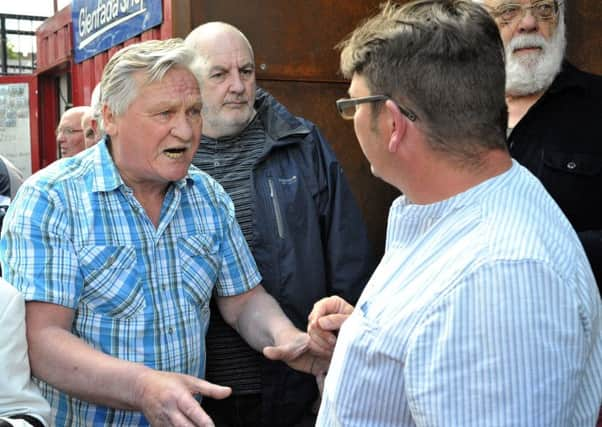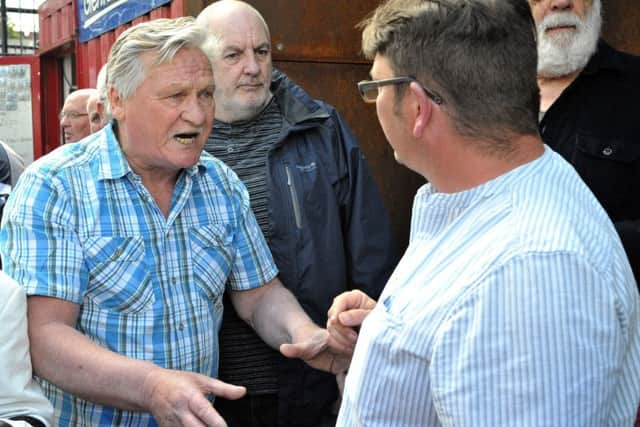Frank exchanges during protest over soldiers' names


Margaret Wray, whose brother Jim Wray was one of the teenagers shot dead on Bloody Sunday, has said she will demand the artefacts currently housed at the museum belonging to her family, including the jacket with the bullet holes he was wearing that day, be returned to them if the soldiers name are not taken off the video installation.
Jean Hegarty, whose teenage brother Kevin McElhinney was also shot and killed on Bloody Sunday, however said she thought it was important that the names of all those killed in the area during the early Troubles period are retained to give a factual account of what happened.
Advertisement
Hide AdAdvertisement
Hide AdThe protest followed a petition with 1,000 names handed into the museum earlier this week calling for the names and details of the soldiers and RUC personnel featured along with civilians killed in Derry between 1969 and 1972 to be removed.


A crowd of over 50 protesters gathered at the entrance to the Glenfada Park museum on Friday afternoon.
There were exchanges of views between people with differing opinions on the installation during the protest.
Speaking during the protest, Margaret Wray said: “Nobody wants peace as much as me and wants the true history recorded, but there is a place for everything, and policemen’s names and British soldiers’ names - that museum is not the place for it, where my grandmother’s windows were shot in that day in that very building, and my brother was just up there.”
Advertisement
Hide AdAdvertisement
Hide AdShe added; “I belong to no organisation or group. I want peace, I’m delighted with peace and I respect all cultures but this is not the place for the list of soldiers and RUC members here. Why are they doing that in here?


She said if the list is not removed she will have the jacket her brother was wearing when he was killed returned to the family.
Jean Hegarty, who works for the Bloody Sunday Trust but said she was speaking in a personal capacity as a family member, however said there security personnel who had died in the same place in the same period as her brother.
Ms. Hegarty said: “It is something we cannot, in telling the truth of the events, ignore. We just cannot do that.
Advertisement
Hide AdAdvertisement
Hide Ad“It is difficult for a lot of people to do that but it is a fact, We cannot change that.”
Ms Hegarty said she understood where the other families opposed to the installation were coming from.
“It hurts, death hurts, there is no doubt about that. You can’t take that pain away.
“Some of the soldiers who died, not on the day of Bloody Sunday, they had parents. I saw how my parents suffered. Their parents, perhaps they had wives, perhaps they had children- they also suffered.
Advertisement
Hide AdAdvertisement
Hide Ad“OK they made a choice to be part of the British army, I can’t change that.
“Those names have been in the museum for ten years. What is different now than it was 10 years ago?”
The organisers of the protest Brian Boyle, who has set up a ‘Not In Free Derry’ Facebook page, said having the names of the solider sand RUC officers alongside civilians killed “was a big ‘no’”.
“I just thought ‘I can’t see that happening’. There has been great support online, people asking to go to the protest.“
Advertisement
Hide AdAdvertisement
Hide AdHe also said there will be more protests if the names are not removed.
A spokesperson for the Bloody Sunday Trust which owns the Museum of Free Derry said today:
“People have a perfect right to demonstrate against the Museum of Free Derry if they so wish.
“The Museum will always listen to those in our community who wish to improve the museum and the way we tell the story of Free Derry.
Advertisement
Hide AdAdvertisement
Hide Ad“It is difficult however for us to understand the purpose of this demonstration as it is based on an inaccuracy. There is no memorial to British soldiers or RUC inside the Museum.
“A memorial is usually called a memorial. It is place where people lay wreaths, say prayers and bow heads. None of that applies to any exhibition or display inside the Museum.
“There is a display which shows the names of all those killed in Free Derry during the Free Derry period, i.e. 1968 to 1972. It includes the names of all those killed whether they be civilian or armed combatants. It is clear from the displays within the Museum that we are highly critical of the role of the British Army and RUC in Derry. It is what the Museum is about telling the story of the Free Derry from the perspective on those who lived through it.
“This display of the names of the dead had been part of the museum for the past ten years. We have never received one single complaint until now.
Advertisement
Hide AdAdvertisement
Hide Ad“We remain gratified at the level of support we continue to receive from within the Derry community and wider, especially the ongoing support of the Bloody Sunday families who for the most part stand solidly behind the Museum and its staff.
“The petition sent to the Museum has been received. We need time to consider it and will respond in due course.”